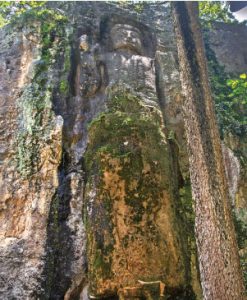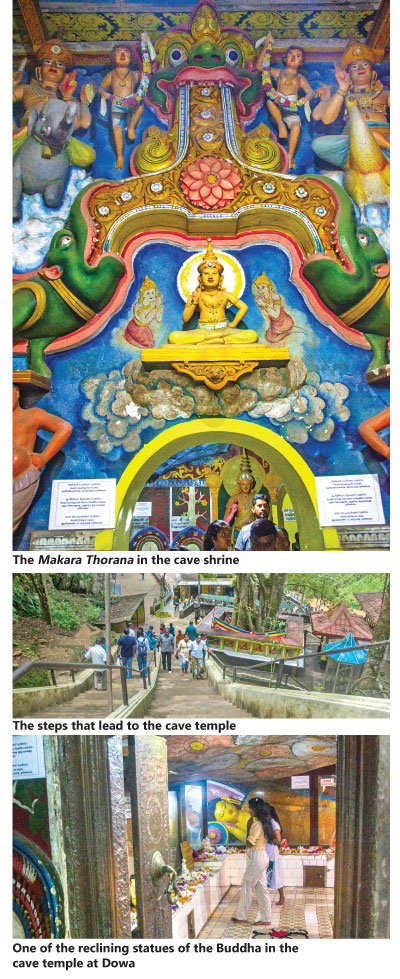 The historic Dowa Raja Maha Vihara lies eight kilometres away from the Bandarawela town on the Bandarawela – Badulla Road. The temple has gained popularity mainly due to its 39 feet tall Buddha Statue carved in granite rock.
The historic Dowa Raja Maha Vihara lies eight kilometres away from the Bandarawela town on the Bandarawela – Badulla Road. The temple has gained popularity mainly due to its 39 feet tall Buddha Statue carved in granite rock.
The incomplete image of the Buddha has been carved out of a rock boulder which is well hidden from the main road. Not much of attention has been given to this statue and it seems to be slowly breaking up. But this temple also hides some secrets that time has forgotten. I had an opportunity to visit this magnificent temple a couple of weeks ago when we headed to Bandarawela.

The 39-ft incompletely carved Buddha image at Dowa temple
The soothing sounds of gushing water reached us as the rock outcrop of the Dowa Temple came into view with unusual shaped white stupa on a rock boulder on the same level as the road and it is the only indication of a temple to a traveller on the road.
Situated on the Badulla-Bandarawela Road, at first, one would only see the modern standing Buddha statue on the centre of the road and quaint white stupa within the temple premises. Entering the quiet environs, it was apparent that the temple buildings were located downhill. Along the path, we went passing the ‘Bana Maduwa’ (the sermon hall) and proceeded down the steps. The sound of the gushing crystal clear water from the nearby stream soon filled our ears.
Bodhi tree and Budhu gey
The Bodhi tree stood serenely at the mid-level, with the Budhu gey (shrine room) at the base. An open sermon hall was towards the side of the Bodhi Tree overlooking the flowing stream. A massive jak tree came into view with its main branch almost at right angles to its trunk. We slowly climbed the rock, our toes gripping the rough grooves.
We looked up to see the large carving of the Buddha in standing posture at 39ft etched on to the rock. The features of the face were serene and exuded a sense of peace and calm. It is believed that this cave temple was built by King Walagamba (103 BCE and c. 89–77 BCE) during the Anuradhapura period. It is also said that the sculpture of the Buddha was done by the King himself who had aimed to finish it overnight. However, the statue seems to be incomplete as if to imply that the King had to leave in a hurry prior to its completion. The cave was one of the many safe places that King Walagamba resided during his 12-years of hiding before reclaiming the Sri Lankan throne from the Chola invaders.
 As you first enter the cave shrine of the temple, you are immediately awed by the beautiful paintings on the cave surface and the colourful statues. The magnetic Makara Thorana and the murals on the walls are well preserved. Though it is said that construction work on the temple was started during the Anuradhapura period, it was completed in the Kandyan period.
As you first enter the cave shrine of the temple, you are immediately awed by the beautiful paintings on the cave surface and the colourful statues. The magnetic Makara Thorana and the murals on the walls are well preserved. Though it is said that construction work on the temple was started during the Anuradhapura period, it was completed in the Kandyan period.
Reflecting this, the Budhu gey we see today depicts features of Kandyan era art and architecture. There is a large reclining statue of the Buddha within. The rock canopy is decorated with various floral motifs. The cave could be considered quite big as it consisted of a series of rooms, one leading to another. The interior was peaceful and calm making us reflect on the Dhamma as we walked through. The spiritual ambience could be felt in our solitude.
On the side of the main entrance to the image house are two guardians, one with an elephant in its mouth and the other with a bull in its mouth. It is said that they are Siva Watuka and Kuvera, two Rakshasa tribal leaders, guarding the entrance to the shrine room. The door frame of the image house in the temple is made of solid rock and has an inscription to say it was built in 1880.
Image house
At the rear of the image house is a small stupa inside a cave. The cave functions as a ‘Stupaghara’ for the stupa. These are generally called Chetiya Len. Behind this stupa, inside the cave is a tunnel called the Ravana Guhawa guarded by a figure of a Clay King Cobra. This 11 km long tunnel is said to be connecting the Ravana Maha Vihara at Ella and the Bogoda Raja Maha Vihara. Unfortunately, this tunnel entrance has been sealed off with cement by the temple due to various vandalism acts by treasure hunters. It said that the King disappeared from the area overnight using the tunnels and thus the work on the Buddha Statue was abruptly stopped.
The temple though seemingly small in size is great in significant due to its contribution to Sri Lankan history. Having provided refuge to King Walagamba, Dowa Temple has seen the world change around it, but has maintained its spirituality and serenity that pervade through time.







